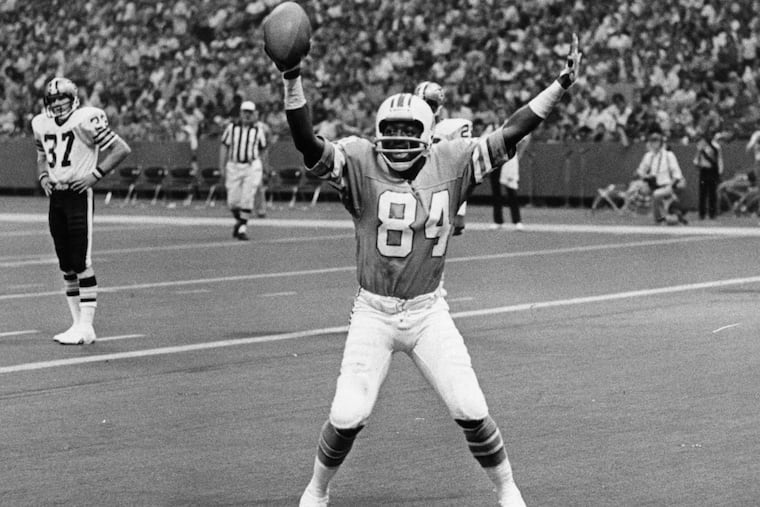The Tiny Dancer who made football history | Frank's Place
But it was when this 5-foot-9, 170-pound flash arrived at Chester's Pennsylvania Military College in 1970 - two years before that school changed its name to Widener - that he made his real contribution to the cultural divide.

Touchdown celebrations, my father believed, were capital offenses.
Every time I saw him witness one, I watched as his hands unconsciously strangled the chair's arm rests, his head tilted threateningly toward the TV, his face turned a Phillies red.
"That guy ought to be put in front of a firing squad," he'd say.
It wasn't, I suspect, an uncommon response among World War II- era men. For many in that emotionally suppressed generation, a pat on the back was an over-the-top gesture of affection.
This season the NFL, which for a time appeared to hold a similar view, has dropped its ban on end-zone revels. And perhaps because these manly merriments now seem as tame and rehearsed as bad dinner-theater, the angry reactions they once provoked – many of them undoubtedly racially tinged – appear to have abated.
Strangely, the Godfather of Gridiron Gyrations, the man who if not their creator was certainly their leading proponent, is wary about their return.
"It is [a good thing]," Billy "White Shoes" Johnson said recently, "as long as they don't go overboard and mess it up again. Some of the stuff they're trying to do now is over the top."
Johnson, 65 now and the associate head coach for Duluth (Ga.) High School's football team, was a cultural revolutionary, outrageous even in the chaotic context of the rebellious late-1960s.
One of eight children of a Marcus Hook police officer, the gregarious Johnson could always outrun anyone in his Delaware County neighborhood. Later, at Chichester High School, he would win a state title in the 220-yard dash. He also played football there and, believing they made him swifter, painted his black cleats white.
"I did feel faster with them on, so I kept wearing them," he said.
But it was when this 5-foot-9, 170-pound flash arrived at Chester's Pennsylvania Military College in 1970 – two years before that school changed its name to Widener – that he made his real contribution to the cultural divide.
As an Oct. 30, 1971, Middle Atlantic Conference matchup with Drexel neared, PMC players were still boiling over a surprising loss to the Dragons a year earlier.
Johnson, a sophomore running back, wide receiver, and kick-returner, vowed that if he scored, he would do the "Funky Chicken" – a dance derived from the 1969 Rufus Thomas song of the same name – in the end zone.
By then, the staid sports world's rigidity was beginning to relax. Joe Namath, another fan of white shoes, wore fur coats, drank openly, and predicted a Super Bowl victory for his Jets. Some NFL players, most notably Homer Jones, had been spiking the ball after scores. And about the same time as Johnson's promise, Kansas City's Elmo Wright had begun to high-step into the end zone.
But as far as anyone knows, the post-TD celebrations hadn't yet gone Soul Train.
Then, sometime in the second quarter of PMC's 40-19 home victory over Drexel, Johnson caught a pass in the flat and broke free on a long scoring play. The "Funky Chicken," in all its rubber-legged glory, debuted.
"I chased him, but by the time I caught him Billy was doing that dance in the end zone," Drexel's Gary Chiusano, now a Sussex County (N.J.) judge, recalled last week. "Now I want to say that Billy is a real gentleman, but at that time I was very insulted. So I slapped him in the back of the helmet and he turned around and threw the football at me. The refs didn't see me, but they called a penalty on him.
"Nowadays that kind of thing is accepted, but back then it wasn't," he said.
The following day's Inquirer made no mention of Johnson's unusual celebration. That wasn't surprising. In 1971, most sports sections were as stiff as goalposts. It would be two more years before the nickname the Widener star had earned at Chichester – "White Shoes" – even appeared in a Philadelphia newspaper.
And it wasn't until 1973, his senior season at Widener, when Johnson led all of Division III in rushing, that anyone in Philadelphia read about his scoring dances.
"I did a crazy-legs dance a while back and I've kept it going," Johnson explained to the Inquirer's Bill Lyon that October. "I just do it to amuse the crowd."
Widener coach Bill Manlove described it then as "a little bit like Elmo Wright's act except Billy adds a few wrinkles. Normally I'd tell him to knock it off, but you get a different reaction in Billy's case. He's such a fine kid none of us gets upset about it. Maybe the college game needs some showmanship."
Johnson, of course, imported his dance into the pros, where he starred and strutted for 14 years with Houston, Atlanta, and Washington of the NFL and for a single season with the Canadian Football League's Montreal Alouettes.
Each of his 35 NFL touchdowns – 25 receiving, two rushing, six on punt returns, two on kickoff returns – was punctuated by a memorable celebration.
The chicken dance was his commemoration of choice, but Johnson occasionally threw in a split or a somersault.
"He's a lovable hot dog," Manlove, who at 84 is still coaching, at Delaware Valley, said of Johnson back then. "You have to know him to love the stuff he does."
My father, whose blood-pressure spiked with every Sunday-afternoon touchdown spike, never knew him. And, like a lot of fathers back then, never understood him either.